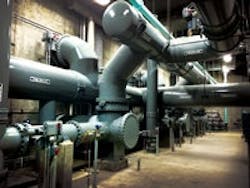About the author: Elisabeth Lisican is managing editor of W&WD. Lisican can be reached at [email protected] or 847.391.1012.
Rialto, located in San Bernadino County, Calif., is known as “Bridge City” and has almost 100,000 residents. It also is home to the Sandhill Surface Water Treatment Plant, a 29-million-gal-per-day (mgd) surface water treatment plant consisting of diatomaceous earth (DE) filtration, conventional filtration, and, most recently, hydroelectric generation.
“I’m happy to say that Sandhill has met or exceeded all of the goals it was designed to achieve,” said Robert K. Young, general manager of the Fontana Water Co., which serves the communities of Fontana, Rialto, Rancho Cucamonga, Ontario and unincorporated areas of San Bernardino County. “Having this facility available has allowed us to manage our water resources in ways that are far more efficient than we ever could have done before.”
A Successful First Six Years
In the summer of 2014, the Sandhill Surface Water Treatment Plant surpassed 2 billion gal of water treated since the plant’s addition of conventional filtration technology officially went online in December 2008. It was designed to treat 12 mgd from all sources, which include Lytle Creek and the State Water Project.
The original plant, built in the mid-1960s, is still in operation; however, its DE technology limits the type of water it can treat. During rainy conditions, when water in Lytle Creek is very turbulent and full of silt, the older DE plant is unable to process it because the filters clog up too quickly.
The updated facility is capable of treating 100% of local surface water from Lytle Creek, 100% of State Water Project Water from the Metropolitan Water District of Southern California, or any combination of the two. Groundwater also is available to either the DE filtration or the conventional filtration train to aid in blending turbid waters.
With the upgraded Sandhill plant, the amount of silt in the water does not matter, which allows the plant to take water from Lytle Creek even during heavy storms.
With the higher capacity and modern technology available at Sandhill, Fontana Water Co. has been able to purchase water from the State Water Project and treat it quickly and efficiently, which helps keep down costs for customers and has helped reduce the impact of the drought.
Challenges & Benefits
As with many surface water treatment facilities, the plant’s staff must constantly be aware of disinfection byproduct formation, which, during the summer months, can be challenging due to algae blooms in local reservoirs. Additionally, algae blooms increase taste- and odor-causing compounds.
The Sandhill plant is at an advantage in that it is at the highest elevation in Fontana’s system; therefore, water produced at the plant can flow by gravity to almost all parts of the system, saving large amounts on electricity needed to pump water out of the ground at well sites in other parts of the service territory.
“We are very excited to see the plant meet and surpass the capacity it was designed for,” Young said. “It really validates our belief that this plant is well designed, well built and will be a major benefit to our customers for many years to come.”
Hydropower Project
In early 2014, lawmakers and Fontana officials cut the ribbon on the Sandhill Hydroelectric Station, which creates enough electricity to power the Sandhill plant and provides excess power to the local utility grid.
Known as “in-conduit” hydroelectric generation, the project takes advantage of existing water flow through the Sandhill plant to produce electricity.
The Sandhill Hydroelectric Station includes a 95-kW turbine and a second 215-kW turbine. Most of the time, the turbines will provide almost all of the power needed to serve onsite power needs at the Sandhill plant, and during high flows they will be able to export excess electricity to the power grid.
From November 2013 to June 2014, the hydropower plant generated 309,000 kWh. Based on the net metering tariff that applies to the hydropower plant, the project saved Fontana Water Co. $45,000 in its first seven months of operation.
“Electricity is one of our biggest expenses, so this will help keep those costs down, which in turn will help hold down the cost of water to our customers,” Young said. “By taking advantage of state and federal grants, this is a very cost-effective project for us.”
Download: Here
